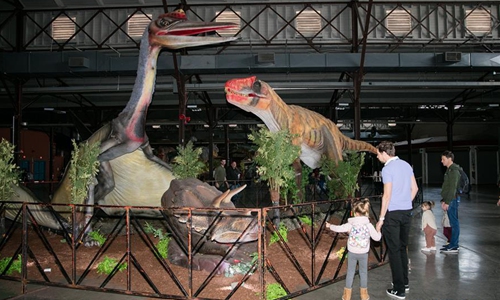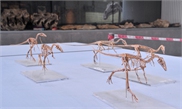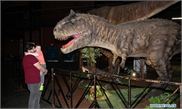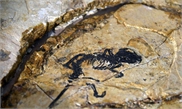‘Gnarly’ tumor shows dinosaurs got cancer; spread to other tissue
'Gnarly' tumor shows dinosaurs got cancer, too
When scientists first unearthed fossils of a horned dinosaur called Centrosaurus in the badlands of Dinosaur Provincial Park in Canada's Alberta Province in 1989, they spotted a badly malformed leg bone they figured was a healed fracture.

The Centrosaurus fibula, a lower leg bone, contained "a massive gnarly tumor larger than an apple," said paleontologist David Evans of the Royal Ontario Museum in Toronto, one of the researchers in the study published in the journal Lancet Oncology.
"This particular Centrosaurus was likely weak and lamed by the cancer prior to its death. This remarkable find shows that no matter how big or powerful some dinosaurs may seem, they were affected by many of the same diseases we see in humans and other animals today, including cancer. Dinosaurs seem like mythical beasts, but they were living, breathing animals that suffered through horrible injuries and diseases," he added. Because most tumors occur in soft tissue that does not readily fossilize, there is scant evidence of cancer in the fossil record.
"Osteosarcoma generally occurs in rapidly growing bones and as such is found in children and young adults. Presumably dinosaurs were also at risk because of the fact that they grew at enormous rates," said study coauthor Dr Mark Crowther, a professor of medicine, pathology and molecular medicine at McMaster University in Ontario.
The tumor destroys the bone and can spread to other tissue, Crowther said.
Its cancer may have reduced mobility.

People watch dinosaur models at the Jurassic Quest exhibition in Dallas, Texas, the United States, on December 8, 2019. Photo: Xinhua
A fresh examination, researchers said on Monday, shows something different. The malformation was a manifestation of osteosarcoma, an aggressive bone cancer, making this Centrosaurus, which lived 76 million years ago, the first known example of a dinosaur afflicted by malignant cancer. About six meters long, Centrosaurus was a four-legged beaked plant-eating Cretaceous Period dinosaur possessing a long horn above its nose and a bony frill above its neck with two smaller hooked horns.The Centrosaurus fibula, a lower leg bone, contained "a massive gnarly tumor larger than an apple," said paleontologist David Evans of the Royal Ontario Museum in Toronto, one of the researchers in the study published in the journal Lancet Oncology.
"This particular Centrosaurus was likely weak and lamed by the cancer prior to its death. This remarkable find shows that no matter how big or powerful some dinosaurs may seem, they were affected by many of the same diseases we see in humans and other animals today, including cancer. Dinosaurs seem like mythical beasts, but they were living, breathing animals that suffered through horrible injuries and diseases," he added. Because most tumors occur in soft tissue that does not readily fossilize, there is scant evidence of cancer in the fossil record.
"Osteosarcoma generally occurs in rapidly growing bones and as such is found in children and young adults. Presumably dinosaurs were also at risk because of the fact that they grew at enormous rates," said study coauthor Dr Mark Crowther, a professor of medicine, pathology and molecular medicine at McMaster University in Ontario.
The tumor destroys the bone and can spread to other tissue, Crowther said.
Its cancer may have reduced mobility.



